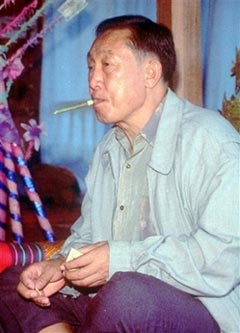Asia's one-time drug warlord Khun Sa dies
Updated: 2007-10-31 10:54
One-time drug warlord Khun Sa, variously described as among the world's most wanted men and a great liberation fighter, has died in Myanmar at the age of 74, an associate said yesterday.
 Khun Sa, shown at this headquarters in Homong, Myanmar on November 22, 1995, has died according to a former secretary. [Agencies] |
Khuensai Jaiyen, a former secretary of Khun Sa who works with ethnic Shan minority guerrilla groups, said his former boss died in Myanmar's largest city Yangon on October 26, according to his relatives.
The cause of death was not immediately known, but Khun Sa had long suffered from diabetes, partial paralysis and high blood pressure.
A Myanmar official in Yangon confirmed the death. He was cremated Tuesday morning, the official said on condition of anonymity.
Khun Sa had lived in seclusion in Yangon since 1996, when he surrendered to the government who allowed him to run a string of businesses behind a veil of secrecy.
At the height of his powers in the 1980s, he led 20,000 men in the largest private army in what was still called Burma. US narcotics officials estimate he was responsible for at least half the heroin flowing out of the region. The Golden Triangle then was by far the biggest supplier of heroin to the world. Washington branded him the "Prince of Death".
For nearly four decades the charismatic warlord claimed to be fighting for autonomy for the Shan, one of many ethnic minorities who have battled Myanmar's central government for decades.
He painted himself as a liberation fighter for the Shan, heading up the Shan United Army in Myanmar's northeastern Shan State. The US offered a $2 million reward for his arrest.
"They say I have horns and fangs. Actually, I am a king without a crown," he told this reporter who visited his remote headquarters of Ho Mong in 1990 after an 11-hour mule ride.
Born of a Chinese father and Shan mother on February 17, 1933, Khun Sa received little education but learned the ways of battle and opium from the Kuomintang, remnants of forces defeated during China's civil war and forced to flee into Myanmar in the late 1940s.
By the early 1960s Khun Sa, also known as Chang Chi-fu, had become a major player in the Golden Triangle - then the world's major source for opium and its derivative, heroin.
He suffered a near knockout blow in the so-called 1967 Opium War, fighting a pitched battle with the Kuomintang in Laos. Laotian troops intervened by bombing both sides and making off with the opium.
For a time he served in a Myanmar government militia, but was jailed in 1969 after allying himself with the Shan cause. He was freed five years later in exchange for two Russian doctors whom his followers had kidnapped.
The wily operator sought a less hostile environment in Thailand, setting up a hilltop base protected by his sizable Shan United Army.
But when the Thais got too embarrassed by having a drug kingpin on their soil, he was driven out in 1982 and lodged himself in Ho Mong, an idyllic valley near the Thai frontier inside Myanmar.
There, the chain-smoking warlord entertained visitors with Taiwanese pop songs and grew orchids and strawberries.
Khun Sa argued that only economic development in the impoverished Shan State, still one of the major sources of the world's heroin, could stop opium growing and its smuggling to the "drug-crazed West".
"My people grow opium. And they are not doing it for fun. They do it because they need to buy rice to eat and clothes to wear," he once said.
He carried out a one-way correspondence with US presidents, offering to sell Washington the entire crop of opium in exchange for funds to implement his development plans for the Shans. But in 1989, he was indicted for heroin trafficking by the US District Court in New York and his extradition to the US was requested.
After decades of guerilla war, Khun Sa signed a peace deal with Myanmar's central government in early 1996.
Since then, the half-Chinese, half-Shan was thought to have been living a life of luxury under government protection in Myanmar's most populous city, despite the $2 million price on his head from Washington.
Agencies
|
|
|
||
|
||
|
|
|
|